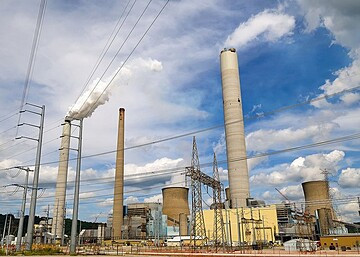"Cleaner air prevents tens of thousands of premature deaths, reduces heart attacks and hospital visits, alleviates hundreds of thousands of child asthma attacks, and prevents millions of lost school and work days."
Both outdoor (ambient) air quality and indoor air quality have far-reaching health impacts, including heart disease, stroke, chronic obstructive pulmonary disease, lower respiratory infections, asthma exacerbations, cancers of the lungs and urinary tract/bladder, preterm birth and more. On this page, we focus on outdoor air quality because indoor air quality issues are discussed in detail on our Built Environment webpage.
Scope of Ambient Air Pollution
In 2014, 92 percent of the world population was living in places that did not meet the World Health Organization (WHO) ambient air quality guidelines levels. WHO also has concluded that in 2012, outdoor air pollution in both city and rural areas accounted for 3 million premature deaths, mostly in low- and middle-income countries and especially in the Western Pacific and South-East Asia regions.2
Types and Sources of Contaminants
The US Environmental Protection Agency (EPA), European Commission and other agencies list these criteria pollutants in ambient air:3
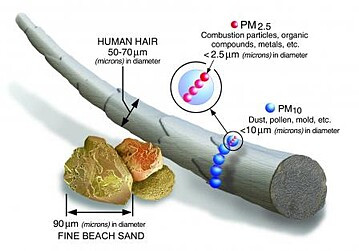
Particulate pollution sizes; image from the US Environmental Protection Agency;4 click to zoom
- Particulates: a mixture of solid particles and liquid droplets that come from construction sites, unpaved roads, fields, smokestacks or fires, but with most particles forming in the atmosphere as a result of complex reactions of chemicals emitted from power plants, industries and automobiles. Particulates are generally classified as PM10 (10 microns in diameter or smaller) and PM 2.5 (2.5 micrometers in diameter or smaller).5
- Ground-level ozone: a product of nitrogen oxides and volatile organic compounds (VOCs) created in the presence of heat and sunlight6
- Lead: sources of lead in ambient air include smelters, ore and metals processing, piston-engine aircraft operating on leaded aviation fuel, waste incinerators, utilities, and lead-acid battery manufacturers7
- Sulfur dioxide: sources include the burning of fossil fuels by power plants and other industrial facilities, and locomotives, ships and other vehicles and heavy equipment that burn fuel with a high sulfur content8
- Carbon monoxide: a gas produced by combustion, with cars, trucks and other vehicles or machinery that burn fossil fuels the greatest sources in outdoor air9
- Nitrogen dioxide: a product of emissions from cars, trucks and buses, power plants, and off-road equipment10
We will also include these pollutants in our review:
- Volatile organic compounds (VOCs): compounds released during manufacture or use of everyday products and materials including organic solvents, some pesticides, flame retardants, and PCBs;12 VOCs are also found in environmental tobacco smoke, stored fuels, exhaust from cars and emissions from industrial facilities13
- Polycyclic aromatic hydrocarbons (PAHs): a group of chemicals found in coal, crude oil and gasoline and which are produced when coal, oil, gas, wood, garbage or tobacco are burned14
- Methane: the primary component of natural gas and a contributor to climate change15
Other pollutants are often found near specific industries or activities. Some examples:
- Petroleum refining releases BTEX compounds (benzene, toluene, ethylbenzene, and xylene)22
- Waste incineration can release dioxins and/or mercury23
- Paper mills release carbonyls such as formaldehyde and acetaldehyde, particulate metals (including lead and chromium) and total reduced sulfur compounds (TRS)24
- Small-scale gold mining can release large amounts of mercury25
- Electronic waste recycling releases heavy metals including copper, lead, cadmium and chromium, plus brominated flame retardants and polychlorinated biphenyls (PCBs)26
Health Impacts
Air pollution is associated with a wide variety of health conditions, from temporary eye, nose and throat irritation to asthma attacks, heart attacks, and respiratory and reproductive issues. This table summarizes evidence regarding health impacts of both air pollution and its components. Data is from CHE's Toxicant and Disease Database unless otherwise noted.
*Definitions of "strong evidence" and "good evidence" can be found on the About the Toxicant and Disease Database webpage.
Worldwide, the majority of air pollution-related deaths are from air-pollution induced heart disease and stroke, followed by air-pollution related chronic obstructive pulmonary disease, lower respiratory infections, and lung cancer.31 In the US, each year some 60,000 people die early because of poor air quality, with costs of air pollution-related illness estimated at $150 billion annually.32
Heart Disease and Stroke
Air pollution: A 2017 review found that short-term increases in air pollution were associated with an increased risk of heart attack, stroke and acute heart failure.33 A separate review that same year found that Increases in stroke incidences and mortalities are seen with air pollution exposure.34

Particulate matter causes sustained oxidative stress and inflammation throughout the body, increasing the rate of cardiovascular deaths. PM2.5 can also increase autonomic nervous system activation.35 Particulate matter can aggravate asthma and is also associated with respiratory symptoms such as increased airway irritation, coughing or difficulty breathing. Children, older adults and anyone with preexisting heart or lung diseases are most vulnerable to the health effects from exposure.36 A 2017 review that pooled epidemiological studies reported that a 10μg/m3 increase in long-term exposure to PM2.5 was associated with an 11 percent increase in cardiovascular mortality.37
Carbon monoxide: High concentrations of carbon monoxide reduce the blood's ability to transport oxygen. People with some types of heart disease, who have reduced ability for getting oxygenated blood to their hearts, are especially vulnerable to the effects of carbon monoxide when exercising or under increased stress, which may result in reduced oxygen to the heart accompanied by chest pain, also known as angina.38 Similar effects are likely from methane.39
Lead: Chronic exposure to lead is associated with cardiovascular effects in adults.40 A review published in 2007 concluded that evidence was sufficient to infer a causal relationship of lead exposure with hypertension, and evidence at the time was suggestive but not sufficient to infer a causal relationship of lead exposure with clinical cardiovascular outcomes.41
Ground-level ozone: The World Health Organization states that in several European studies, daily heart disease mortality rises by 0.4 percent per 10 µg/m3 increase in ground-level ozone exposure.42
Respiratory Disease and Asthma
Air pollution: Both chronic and acute respiratory diseases are associated with air pollution. Strong evidence shows that pollution acts as an asthma irritant, causing asthma episodes, which are sometimes called asthma attacks.4344 Meta-analyses in a 2017 report showed statistically significant associations between prenatal exposures to nitrogen dioxide, sulfur dioxide, and PM10 and the risk of wheezing and asthma development in childhood.45
Nitrogen dioxide: Brief exposure to nitrogen dioxide can cause inflammation of the airways. Symptoms of bronchitis in asthmatic children increase in association with long-term exposure. Current levels of nitrogen dioxide in major cities in Europe and North America can reduce lung function.46
Sulfur dioxide: Brief exposure to sulfur dioxide can make breathing difficult and aggravate asthma.47
Ozone exposure can reduce lung function and cause respiratory symptoms. Ozone is a major factor in asthma morbidity and mortality, while nitrogen dioxide and sulfur dioxide contribute to asthma, bronchial symptoms, lung inflammation and reduced lung function.48
Reproductive Health
A 2017 review concluded that evidence from both animal and human epidemiological studies provide support that air pollutants cause defects during gametogenesis leading to a drop in reproductive capacities in exposed populations.49 A meta-analysis in 2015 found a significantly increased risk of preterm birth per 10 μg/m3 increase in PM10 and PM2.5 exposure throughout pregnancy.50 A 2017 review and meta-analysis found that maternal exposure to fine particulate air pollution (PM2.5) increases the risk of preterm birth and term low birth weight,51 while a 2016 analysis concluded that more than 3.3 percent of preterm births in 2010 in the US were attributable to PM2.5 exposure, with costs estimated at $5.09 billion.52
Cancer
In 2016, the WHO’s International Agency for Research on Cancer (IARC) classified both air pollution and particulate matter in polluted air as Class 1 human carcinogens, concluding that there is sufficient evidence that air pollution and particulate matter each cause lung cancer, and that outdoor air pollution is associated with cancer of the urinary bladder.53
Learning and Developmental Disabilities
Air pollution and particulate matter: Human studies from India, Boston, Cincinnati, New York City, China, Barcelona and Japan indicate that particulate exposure, primarily from vehicle exhaust, is associated with executive function deficits in preschoolers and school-aged children.54 A 2016 review found that air pollution may be associated with the incidence of autism spectrum disorders,55 consistent with a 2015 analysis that found that higher maternal exposures to PM2.5, especially during the third trimester of pregnancy, was associated with greater odds of a child having autism spectrum disorder.56
Lead: Air-borne lead can damage the developing nervous system of children, increasing the risk for learning deficiencies, behavioral problems and impaired cognitive development and function.57
PAHs: A 2006 study of nonsmoking African-American and Dominican mothers and children in New York City concluded that high prenatal exposure to PAHs was associated with lower mental development index at age three and higher risk of cognitive developmental delay.58
Neurocognitive Decline
A 2012 study found that children and young adults with a genetic predisposition to developing Alzheimer’s disease (APOE allele ∊4) who were exposed to significant air pollution developed a greater number of protein markers known to increase the risk of Alzheimer’s disease (tau proteins and Aβ plaques). This finding suggests that genetic factors could make a significant number of children exposed to air pollution more prone to developing Alzheimer’s disease later in life.59 A review published in 2015 found associations of air pollution with global cognitive function, verbal and nonverbal learning and memory, and activities of daily living.60 A 2017 review further revealed that both children and older adults exposed to air pollution exhibited signs of cognitive dysfunction, and that air pollution was associated with exacerbations of neurodegenerative conditions such as Alzheimer's and Parkinson's diseases.61
Mental Health
Some evidence ties air pollution to a in increased risk of a variety of mental health conditions. A 2017 review found an association between air pollution, especially particulates, and suicidality.62 A separate 2017 review concluded that constituents of air pollution such as particulate matter and nitrogen and sulfur oxides could be component causes for schizophrenia.63 A review published in 2015 found associations of air pollution with depressive symptoms and elevated anxiety.64
Risks to Children
Prenatal Exposures and Child HealthEnvironmental pollution is believed to cause inflammation and oxidative stress in a mother’s body that subsequently alters the placenta, impairs the transport of oxygen and nutrients to the developing child and may disrupt epigenetic mechanisms important for development. These effects may cause changes in the child's birth weight, immune system and lung function. Exposure to air pollution may cause the development of asthma in the child, and impaired lung development contributes to infant mortality.65
image from lunar caustic at Creative Commons |
Children are especially vulnerable to air pollution for several reasons:66
- Children have a higher breathing rate than adults relative to their body size.
- Children in some cultures and societies spend more time outdoors than adults.
- The body’s natural barriers, such as the epithelium and the blood-brain barrier, are not fully developed, and thus can not prevent the passage of airborne pollutants into the body and brain as effectively as adult bodies can.
Neuroinflammation
Air pollution, and specifically particulate matter, can increase immune activity and cell neuroinflammation. This inflammation then leads to cell damage and loss in the developing brain in areas such as the prefrontal cortex, olfactory bulb and hippocampus, all areas critical to cognitive function.67
Lung Development
Because lung development starts within the first two months of gestation and extends possibly into adulthood, the effects of air pollution on developing lungs can proceed over much of a child's life. Developing lungs don’t have full capacity for self-repair, and so the effects of exposure to pollution can be lifelong. Prenatal exposure to air pollution is associated with reduced lung function and reduced respiratory health in infancy. Exposure also increases the risk for prematurity and low birth weight, both of which are risk factors for impaired respiratory health later in life. Increased exposure to outdoor air pollution soon after birth is associated with smaller lungs and respiratory impairment. In a study of 3.5 million births across 96 countries, the highest levels of air pollution were associated with a higher risk for infant death from respiratory complications.68
Infant Mortality
Several studies provide good evidence for an association between air pollution exposure during pregnancy and infant mortality.69
Indoor Air Quality
In addition to the particulates, lead, carbon monoxide, VOCs and PAHs discussed above, indoor air can also contain these pollutants, often in higher concentrations—and sometimes substantially higher concentrations—than outdoor air:
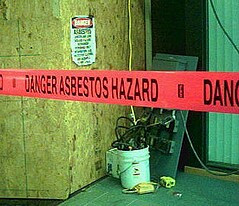
- Radon
- Asbestos
- Mercury
- Mold
- Flame retardants
- Formaldehyde
Indoor air contaminants typically come from these sources:

- Indoor wood or gas heating
- Cooking
- Tobacco use
- Candles or incense
- Aerosols and cleaning products
- Fabrics
- Building materials
- Paints and finishes
- Solvents
- Cosmetics
- Air fresheners
- Plastics
- Glues
The World Health Organization estimates that 4.3 million premature deaths were attributable to household air pollution in 2012. Almost all of that burden was in low- and middle-income countries, with indoor smoke the primary contributor.70
Indoor air quality and health impacts are discussed in greater detail on our Built Environment webpage.
Prevention and Regulation
Some prevention of exposures is under individual control—such as addressing sources of carbon monoxide or radon exposure in buildings—but individual action cannot address pollution in whole neighborhoods, regions and countries. Local, state and federal government oversight is needed to promote clean air and protect residents from widespread air contamination. This oversight generally comes through setting air quality standards enforced through regulation of polluters and of the production or use of polluting materials.
The World Health Organization (WHO) has established air quality guidelines (AQGs) designed to support and guide countries in developing their own national air quality standards. In addition to the ultimate guideline values, interim targets are given for each pollutant. Very few countries' standards currently meet all the WHO AQGs; Australia is an exception, with all criteria pollutant standards meeting or exceeding WHO's AQGs.71 This does not mean that Australia's air always meets these standards, but that the target levels of air pollutants complies with the WHO AQGs.
|
image from Hamed Saber at Creative Commons |
WHO has concluded that policies and investments supporting these goals would reduce key sources of urban ambient air pollution:
- Cleaner transportation
- Energy-efficient housing
- Cleaner power generation and industry
- Better municipal waste management
In addition, reducing emissions from these sources would reduce key rural and peri-urban air pollution sources in developing regions:
|
image from Gerry at Creative Commons |
- Household coal burning and biomass energy systems
- Agricultural waste incineration
- Forest fires
- Agro-forestry activities such as charcoal production
WHO estimates that reducing the concentration of PM10 from 70 micrograms per cubic meter to 20 micrograms per cubic meter would reduce air pollution-related death by about 15 percent.72
Regulatory Actions
United States
Key US federal laws and regulations regarding air quality:73
|
President George HW Bush signs the 1990 Clean Air Act; image from the US Environmental Protection Agency |
1970 Clean Air Act (CAA), amended in 1990, with these requirements:
- Major stationary sources of pollutants must install pollution-control equipment and meet specific emissions limitations.
- Major stationary sources must obtain operating permits.
- The EPA must set National Ambient Air Quality Standards (NAAQS) for the six criteria air pollutants.
- EPA administers programs that protect the stratospheric ozone layer.
- EPA regulates emissions of toxic air pollutants from a published list of industrial sources referred to as "source categories." Toxic air pollutants include mercury, PCBs, benzene and volatile organic compounds (VOCs).
Cross-State Air Pollution Rule requires certain states in the eastern US to improve air quality by reducing power plant emissions that cross state lines and contribute to smog and soot pollution in downwind states.
2015 Clean Power Plan, which in 2017 is under Executive Order for review, and thus its implementation and enforcement are uncertain.
Canada
Canada established national ambient air quality objectives (NAAQOs) from1989 to 1996. In 2013, updated air quality standards were established by the federal government, bringing standards for PM2.5 and ozone into compliance (or very close) with the WHO AQGs.74
European Union
The European Commission has established air quality standards for the six criteria air pollutants, plus benzene, arsenic, cadmium, nickel and polycyclic aromatic hydrocarbons (PAHs).75
Australia
In 1998, the National Environment Protection Council (NEPC) created Australia's first national ambient air quality standards as part of the National Environment Protection Measure for Ambient Air Quality (the 'Air NEPM'). This measure set standards for the six criteria pollutants. In 2004, NEPC made the National Environment Protection (Air Toxics) Measure (known as the 'Air Toxics NEPM'), establishing "monitoring investigation levels" for five air toxics: benzene, formaldehyde, benzo(a)pyrene as a marker for PAHs, toluene and xylenes. Australia does not have national air quality emissions standards, as these are set by environment protection authorities in individual states and territories.76
Asia
Most Asian countries have adopted National Ambient Air Quality Standards (NAAQS) for the criteria pollutants except for PM2.5. However, a 2010 assessment reported that standards of most countries lag behind WHO air quality guidelines.77
Latin America
Several countries in Latin America have established air quality standards, although many lag far behind the WHO air quality guidelines. Five countries have no established guidelines, and no information was available from two countries in a 2012 report from the Clean Air Institute.78
Africa
The scarcity of data and information on air quality in Africa prevents an informed analysis. Although the majority of countries have established national air quality standards, only a quarter of countries have advanced fuels and vehicles standards.79
Benefits from Regulation
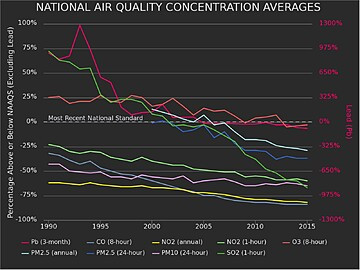
Trends in air quality since the passage of the 1990 Clean Air Act in the US; image from the US Environmental Protection Agency;80 click to zoom
As a result of EPA's regulatory efforts to remove lead from motor vehicle gasoline, levels of lead in the air decreased by 89 percent between 1980 and 2010.81 Other reductions in air pollutants, providing substantial improvements for the health of residents, shown in the graph at right:82
- 77 percent of 8-hour carbon monoxide
- 99 percent of 3-month average of lead
- 54 percent of annual nitrogen dioxide
- 47 percent of 1-hour nitrogen dioxide
- 22 percent of 8-hour ozone
- 39 percent of 24-hour PM10
- 37 percent of annual PM2.5
- 37 percent of 24-hour PM2.5
- 81 percent of 1-hour sulfur dioxide
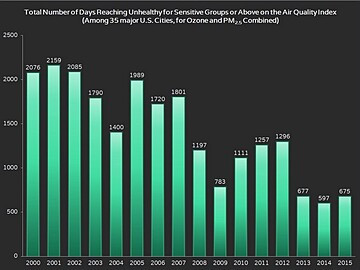
Air quality trends 2000-2015; image from the US Environmental Protection Agency;83 click to zoom
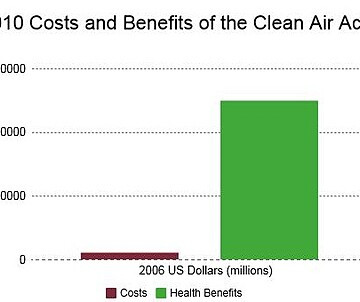
Clean Air Act costs and benefits, 2010; image from Nancy Hepp with data the US Environmental Protection Agency;84 click to zoom
From 2000 to 2015, the number of days in which the combined ozone and PM2.5 Air Quality Index (AQI) reached unhealthy levels for sensitive populations has trended downward (graph at right).85
The 2011 version of the EPA's analysis of the benefits and costs of the Clean Air Act concluded that in in 2010, the Clean Air Act Amendments prevented 160,000 premature deaths, with health benefits worth $1.247 trillion ($1,247,000,000,000). EPA's central benefits estimate of the CAA exceeds its costs by a factor of more than 30 to one, as shown in the graph at right.86
EPA projected that in 2020 the benefit will increase to preventing more than 230,000 premature deaths. About 85 percent of the economic benefits are from reductions in premature mortality associated with reductions in ambient particulate matter.87
Although US national air quality has improved significantly since the passage of the 1970 Clean Air Act and the 1990 Amendments, some communities are still exposed to unsafe levels of air pollution.88 For example, in 2015, 127 million US residents lived in counties where ground-level ozone exceeded the national standards.89
See more about air quality in the list of CHE publications and Dig Deeper resources in the right sidebar.
This page's content was created by Lorelei Walker, PhD, and Nancy Hepp and last revised in October 2017.
CHE invites our partners to submit corrections and clarifications to this page. Please include links to research to support your submissions through the comment form on our Contact page.
* header image from V.T.Polywoda at Creative Commons

